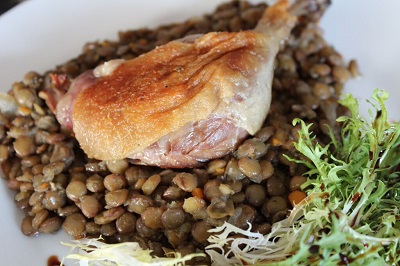Start 14-Day Trial Subscription
*No credit card required

Unwind with a French Twist
High in the Colorado Rockies there’s a food truck that goes by the name of Louise. In a previous incarnation, Louise served gourmet grilled cheese sandwiches. Recently though, she’s undergone a complete transformation at the hands of Chef Michael DeBoer. At 5pm on Friday, June 26, at Eastman Park in Boulder, Chef DeBoer will unveil Louise as The French Twist Truck, Boulder’s finest French restaurant on four wheels.
Classically trained at The Culinary Institute of America, Chef DeBoer has spent the last twenty years in the kitchens of upscale restaurants in New York, Denver and Boulder. He’s always wanted to own a restaurant that fits his image of real French dining, and now he does. “Whether it’s a crêpe on the side of the road from a food truck or foie gras at a high-end place,” he says, “to relax and enjoy it is really what I consider French dining.”
Using locally sourced ingredients, Chef DeBoer’s menu shows his twist on French cuisine. There are classic dishes, like sweet or savory crêpes and duck confit, but he’s also included items more associated with French street food, like pommes pailles (shoe-string potatoes). Salads, soups and desserts, including the decadent pear tart tatin, round out the menu, offering guests a complete taste of the French eating experience.
For those lucky enough to live within a 60-mile radius of Boulder, the restaurant’s website (www.thetwisttruck.com) provides up-to-the-minute updates on the newly remodeled Louise's location. Craft beer lovers will be able to find the French Twist regularly at Upslope and Vindication Brewing Companies. Who would have thought twenty years ago that one could experience fine craft beer with equally exquisite French food?
If you’re outside of Colorado, you can still experience some of the chef’s food with a good craft brew. He’s supplied us with the recipe for his signature dish, duck confit. Just the name of it can be intimidating, but Chef DeBoer’s instructions are straightforward. The hardest part is planning the time it takes to make it, and the rewards are extraordinary. Served on top of a bed of lentils, alongside frisée with a balsamic reduction, even the most discerning foodie will be impressed.
Pair this dish with a full-bodied acidic beer, such as New Belgium’s La Folie Wood-Aged Sour Ale or Paradox’s Skully Barrel No.22 Sour Elderberry Ale (paradoxbeercompany.com). Even those who do not favor sours may approach them in a new light after experiencing how well they complement the confit.
French Twist Duck Confit by Michael DeBoer
Makes 12 servings.
Ingredients:
12 duck legs
4 cups salt
1 cup sugar (Amount varies with size of duck legs; needs to cover ducks ⅛-inch thick. Keep a 4-to-1 ratio.)
⅛ cup fresh cracked black pepper
6 cups rendered duck fat or a neutral vegetable oil
3 bay leaves
12 black peppercorns
Fresh thyme

Directions:
Place duck legs on a wire rack over a sheet pan large enough to catch the juices while the duck is curing. Set aside.
Mix the salt, sugar and pepper and pack the duck legs with the mixture. The coverage should be at least an eighth of an inch thick. If the duck legs are large, you may need to increase the volume of this mix, keeping a 4-to-1 ratio of salt to sugar, adding pepper appropriately.
Place a baking sheet on top of the seasoned legs and weight it so it is pressed. Refrigerate for 12 to 16 hours to cure.
When ready to cook, preheat oven to 250°F. Remove the duck legs and rinse well.
Place the duck legs in a thick, oven-suitable pan, such as a Dutch oven. Smother with rendered duck fat or a neutral vegetable oil. Use more fat or oil as needed to completely submerge the legs in fat. This will ensure no part of the duck dries out in the next steps.
Add bay leaves, peppercorns and fresh thyme to the fat.
Cook uncovered on low to medium heat on the stovetop until small bubbles start to form, about 20 to 25 minutes.
Cover with a form-fitting lid and place in preheated oven. Cook until the meat falls off the bone; a minimum of four hours.
To serve immediately, remove legs from pan. Place in a skillet on medium heat until the skin browns.
If not serving immediately, set the pan on the countertop and cool to room temperature. Once cool, transfer the duck legs and fat to a storage container and refrigerate.
To reheat, remove the legs from the refrigerator and scrape off residual fat. Place in a pan on medium heat until the legs are warmed through and the skin browns.



